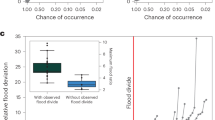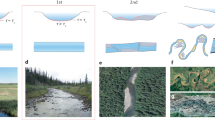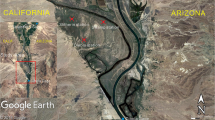Abstract
The time it takes for rainfall to travel through a catchment and reach the stream is a fundamental hydraulic parameter that controls the retention of soluble contaminants and thus the downstream consequences of pollution episodes1,2. Catchments with short flushing times will deliver brief, intense contaminant pulses to downstream waters, whereas catchments with longer flushing times will deliver less intense but more sustained contaminant fluxes. Here we analyse detailed time series of chloride, a natural tracer, in both rainfall and runoff from headwater catchments at Plynlimon, Wales. We show that, although the chloride concentrations in rainfall have a white noise spectrum, the chloride concentrations in streamflow exhibit fractal 1/f scaling over three orders of magnitude. The fractal fluctuations in tracer concentrations indicate that these catchments do not have characteristic flushing times. Instead, their travel times follow an approximate power-law distribution implying that they will retain a long chemical memory of past inputs. Contaminants will initially be flushed rapidly, but then low-level contamination will be delivered to streams for a surprisingly long time.
This is a preview of subscription content, access via your institution
Access options
Subscribe to this journal
Receive 51 print issues and online access
$199.00 per year
only $3.90 per issue
Buy this article
- Purchase on Springer Link
- Instant access to full article PDF
Prices may be subject to local taxes which are calculated during checkout



Similar content being viewed by others
References
Langmuir, D. Aqueous Environmental Geochemistry (Prentice-Hall, Upper Saddle River, New Jersey, 1997).
Schnoor, J. L. Environmental Modeling: Fate and Transport of Pollutants in Water, Air, and Soil (Wiley, New York, 1996).
Neal, C. & Rosier, P. T. W. Chemical studies of chloride and stable oxygen isotopes in 2 conifer afforested and moorland sites in the British uplands. J. Hydrol. 115, 269– 283 (1990).
Neal, C. et al. The hydrochemistry of the River Severn, Plynlimon. Hydrol. Earth Syst. Sci. 1, 583–617 (1997).
Robson, A., Neal, C., Hill, S. & Smith, C. J. Linking variations in short-term and medium-term stream chemistry to rainfall inputs – some observations at Plynlimon, mid-Wales. J. Hydrol. 144, 291–310 (1993).
Neal, C. et al. Chloride in precipitation and streamwater for the upland catchment of the River Severn, mid-Wales: some consequences for hydrochemical models. Hydrol. Process. 2, 155– 165 (1988).
Kirkby, C., Newson, M. D. & Gilman, K. Plynlimon research; the first two decades (Institute of Hydrology Report 109, Institute of Hydrology, Wallingford, UK, 1991).
Neal, C., Hill, T. & Reynolds, B. Acid neutralisation capacity measurements in surface and groundwaters in the upper River Severn, Plynlimon: from hydrograph splitting to water flow pathways. Hydrol. Earth Syst. Sci. 1, 687–696 (1997).
Neal, C. et al. The occurrence of groundwater in the lower Palaeozoic rocks of upland Wales. Hydrol. Earth Syst. Sci. 1, 3– 18 (1997).
Buttle, J. M. Isotope hydrograph separations and rapid delivery of pre-event water from drainage basins. Prog. Phys. Geog. 18, 16 –41 (1994).
Sklash, M. G., Beven, K. J., Gilman, K. & Darling, W. G. Isotope studies of pipeflow at Plynlimon, Wales, UK. Hydrol. Process. 10, 921–944 (1996).
Beven, K. On subsurface stormflow: predictions with simple kinematic theory for saturated and unsaturated flows. Wat. Resour. Res. 18, 1627–1633 (1982).
Bracewell, R. N. The Fourier Transform and its Applications 3rd edn (McGraw-Hill, Boston, 2000).
Scargle, J. D. Studies in astronomical time series analysis. II. Statistical aspects of spectral analysis of unevenly spaced data. Astrophys. J. 263, 835–853 (1982).
Avnir, D., Biham, O., Lidar, D. & Malcai, O. Is the geometry of nature fractal? Science 279, 39– 40 (1998).
Duffy, C. J. & Gelhar, L. W. A frequency domain approach to water quality modeling in groundwater: theory. Wat. Resour. Res. 21, 1175–1184 ( 1985).
Duffy, C. J. & Gelhar, L. W. A frequency domain analysis of groundwater quality fluctuations: interpretation of field data. Wat. Resour. Res. 22, 1115–1128 (1986).
Rodhe, A., Nyberg, L. & Bishop, K. Transit times for water in a small till catchment from a step shift in the oxygen-18 content of the water input. Wat. Resour. Res. 32, 3497–3511 (1996).
Niemi, A. J. Residence time distributions of variable flow processes. Int. J. Appl. Radiat. Isotopes 28, 855–860 (1977).
Gelhar, L. W. Stochastic Subsurface Hydrology (Prentice-Hall, Englewood Cliffs, NJ, 1993).
Bain, L. in Encyclopedia of Statistical Sciences (eds. Kotz, S. & Johnson, N. L.) 292–298 (Wiley, New York, 1983).
Turner, J. V. & Barnes, C. J. in Isotope Tracers in Catchment Hydrology (eds Kendall, C. & McDonnell, J. J.) 723– 760 (Elsevier, Amsterdam, 1998).
Kreft, A. & Zuber, A. On the physical meaning of the dispersion equation and its solutions for different initial and boundary conditions. Chem. Eng. Sci. 33, 1471– 1480 (1978).
Sposito, G., White, R. E., Darrah, P. R. & Jury, W. A. A transfer function model of solute transport through soil 3. The convection-dispersion equation. Wat. Resour. Res. 22, 255– 262 (1986).
Stewart, M. K. & McDonnell, J. J. Modeling base flow soil water residence times from deuterium concentrations. Wat. Resour. Res. 26, 3005–3019 ( 1991).
Kavanaugh, M. C. et al. Alternatives for Ground Water Cleanup (National Academy Press, Washington, DC, 1994).
Turcotte, D. L. Fractals and Chaos in Geology and Geophysics (Cambridge University Press, 1992).
Korvin, G. Fractal Models in the Earth Sciences (Elsevier Science, Amsterdam, 1992).
Neal, C. A view of water quality from the Plynlimon watershed. Hydrol. Earth Syst. Sci. 1, 743–754 ( 1997).
Acknowledgements
Our collaboration was supported by a National Science Foundation grant to J.W.K. Sample collection and analysis were supported by the Natural Environment Research Council, the Environment Agency of England and Wales, and the Forestry Commission. We thank the Plynlimon field staff for sample collection, M. Neal for sample analysis, C. Stark for comments on the manuscript, and D. Brillinger for helpful advice.
Author information
Authors and Affiliations
Corresponding author
Supplementary information
Rights and permissions
About this article
Cite this article
Kirchner, J., Feng, X. & Neal, C. Fractal stream chemistry and its implications for contaminant transport in catchments. Nature 403, 524–527 (2000). https://doi.org/10.1038/35000537
Received:
Accepted:
Issue Date:
DOI: https://doi.org/10.1038/35000537
This article is cited by
-
Multi-year time series of daily solute and isotope measurements from three Swiss pre-Alpine catchments
Scientific Data (2024)
-
Block-circulant with circulant-block preconditioners for two-dimensional spatial fractional diffusion equations
Numerical Algorithms (2024)
-
Seasonal and Long-Term Water Quality of Alfeios River Basin in Greece
Water, Air, & Soil Pollution (2024)
-
A fast linearized virtual element method on graded meshes for nonlinear time-fractional diffusion equations
Numerical Algorithms (2024)
-
An economic implementation of the optimal rotated block-diagonal preconditioning method
Numerical Algorithms (2023)
Comments
By submitting a comment you agree to abide by our Terms and Community Guidelines. If you find something abusive or that does not comply with our terms or guidelines please flag it as inappropriate.



